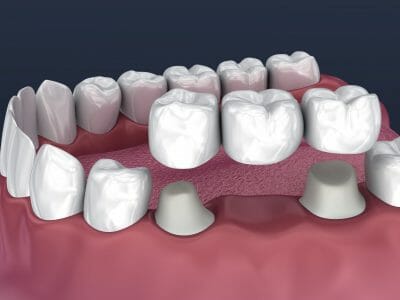Bridges
 What is a dental bridge?
What is a dental bridge?
A dental bridge is a type of dental prosthesis that is used to bridge a gap or multiple gaps in your smile when one or more teeth are missing. A fixed bridge is composed of a false tooth, known as a pontic, or several pontics, anchored in position by the abutment teeth on each side of the missing teeth.
Pontics may be crafted from a variety of materials, but in most cases, they’re crafted from porcelain to match the color of your natural tooth enamel.
Different types of dental bridges
Traditional bridge – A traditional bridge consists of a pontic that is anchored onto dental crowns that are bonded onto the abutment teeth on either side of the gap. Millions of individuals are fitted with traditional bridges. This type of bridge may be appropriate for you if you still have stable teeth on either side of the gap that are strong enough to support the bridge.
Maryland bridge – Similar to a traditional bridge, a Maryland bridge uses two abutment teeth, one on each side of the gap. The difference is that, instead of being anchored to crowns on the abutment teeth, a Maryland bridge is anchored to the abutment teeth using a metal or porcelain structure that is bonded onto the backside of these teeth.
Cantilever bridge – The cantilever bridge resembles a traditional bridge with the difference being that the cantilever bridge is used in cases where there is only one abutment tooth available. The cantilever bridge uses a single pontic anchored to a dental crown that is cemented to the sole abutment tooth.
Implant-supported bridge – Considered the most stable type of bridge, and used with patients who have multiple teeth missing, the implant-supported bridge is a multi-step process that begins with two oral surgeries required to place the implants into the jawbone. Implants are small metal screws that replace the roots of lost teeth. Once the surgery from the implant procedure has healed, the bridge is anchored to the implants. This solution usually takes several months to complete, because a period of healing is required between surgeries and before the bridge can be positioned. The implant-supported bridge uses an implant to replace each missing tooth root, and the bridge is then anchored to each implant. In cases where it is not feasible to insert one implant for each missing tooth, a pontic may be positioned between two crowns that are anchored to implants.
When is a dental bridge necessary?
A dental bridge is an optimal solution for patients who are missing one or more teeth. The underlying bone tissue that supports your teeth is impacted seriously when a tooth is lost. Missing teeth may impact an individual’s ability to eat comfortably as well as their cosmetic appearance. Missing teeth may also lead to more severe dental problems if not replaced.
If the missing tooth is not replaced shortly after it is lost, bone loss begins to set in. If it progresses, it will cause your facial structure to change, making your facial muscles and skin sage, and imparting an aged appearance to the face. A dental bridge is designed to prevent the continued bone loss that results from missing teeth. It also provides structural support for your facial muscles and helps restore your face’s natural shape.
A bridge may also be used to correct chewing problems by replacing missing teeth. This redistributes and balances the pressure of your bite. Your “bite” refers to how your top and bottom teeth come together when your mouth closes. In many patients, the correction provided by a dental bridge may alleviate headaches and other discomfort caused by a misaligned dental bite.
A dental bridge will also keep your surrounding teeth from shifting position because over time, teeth will gradually begin to shift positions to fill in gaps in the gum line.
How long do dental bridges last?
Dental bridges are designed to last between 5 and 15 years, but many patients have had bridges last much longer. With a regimen of good oral hygiene, regular checkups, and proper care, your dental bridge could last well over 10 years.
If you’d like to beautify your smile and protect your teeth with a dental bridge, contact our office in West Bend today.

 What is a dental bridge?
What is a dental bridge?